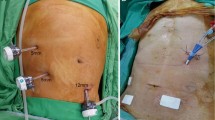Abstract
Background
Whipple procedure has been described since 1935,1 using classic open surgery. With the advent of minimally invasive surgery (MIS), it has been described to be feasible using the latest technology.2 , 3 In this video the authors report a full laparoscopic Whipple procedure, realizing the three anastomoses by intracorporeal handsewn method.
Video
A 70-year-old man who presented with adenocarcinoma of the ampulla of Vater, infiltrating the pancreatic parenchyma underwent to a laparoscopic Whipple. Preoperative work-up shows a T3N1M0 tumor.
Results
No perioperative complications were registered. The pancreatico-jejunostomy was created in end-to-side fashion using two PDS 3/0 running sutures (Fig. 1), the hepatico-jejunostomy in end-to-side method using two PDS 4/0 running sutures (Fig. 2), and the gastro-jejunostomy in end-to-side method using two PDS 1 running sutures (Fig. 3). Total operative time was 8 h 20 min. Time for the dissection was 6 h 20 min, time for the specimen’s extraction was 20 min, and time for the three laparoscopic intracorporeal handsewn anastomoses was 1 h 40 min. Operative bleeding was 350 cc. Patient was discharged on postoperative day 9. Pathologic report confirmed the moderately differentiated adenocarcinoma of the ampulla of Vater, with perinervous infiltration and lymphovascular emboli, free margins, 2 metastatic lymphnodes on 23 isolated; 8 edition UICC stade: pT3bN1.
Conclusions
Laparoscopic Whipple remains an advanced procedure to be performed by laparoscopy as well as by open surgery. All the advantages of MIS, such as reduced abdominal trauma, less postoperative pain, shorter hospital stay, improved patient’s comfort, and enhanced cosmesis are offered using using laparoscopy.
Similar content being viewed by others
References
Whipple AO, Parsons WB, Mullins CR. Treatment of carcinoma of the ampulla of Vater. Ann Surg 1935;102:763–79.
Gagner M, Pomp A. Laparoscopic pancreatic resection: is it worthwhile? J Gastrointest Surg 1997;1(1):20–5.
Giulianotti PC, Sbrana F, Bianco FM, Elli EF, Shah G, Addeo P, Caravaglios G, Coratti A. Robot-assisted laparoscopic pancreatic surgery: single-surgeon experience. Surg Endosc 2010;24(7): 1646–57.
Disclosure
The author has no conflicts of interest or financial ties to disclose regarding this video.
Author information
Authors and Affiliations
Corresponding author
Electronic supplementary material
Below is the link to the electronic supplementary material.
The Whipple procedure is an advanced surgery to be performed by laparoscopy, as well as by open surgery. During a full laparoscopic Whipple, the three anastomosis can be performed by intracorporeal handsewn method, like showed in this video. Supplementary material 1 (MP4 85978 kb)
Rights and permissions
About this article
Cite this article
Dapri, G., Bascombe, N.A., Gerard, L. et al. Completely Intracorporeal Handsewn Laparoscopic Anastomoses During Whipple Procedure. Ann Surg Oncol 24, 2785–2786 (2017). https://doi.org/10.1245/s10434-017-5944-x
Received:
Published:
Issue Date:
DOI: https://doi.org/10.1245/s10434-017-5944-x



